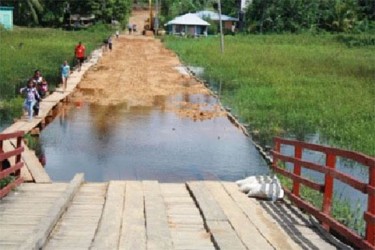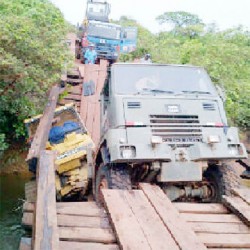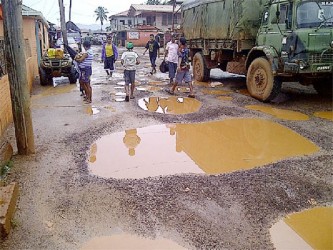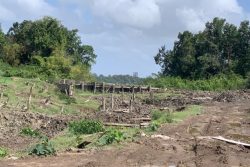By David A. Granger
Hinterland Guyana comprises over three-quarters of this country’s territory. The Barima-Waini, Cuyuni-Mazaruni, Potaro-Siparuni and Upper Essequibo-Upper Takutu (Rupununi) and parts of the East Berbice-Corentyne and Upper Demerara-Berbice Regions – might be most picturesque parts of the country but they are the poorest.
Central Government policy over the past two decades has been dangerously dividing Guyana more deeply into two nations. It is creating an East-West divide that separates the lands West of the Essequibo River from what lies to the East. That policy has perpetuated the disparities, divergences and divisions which hinder development.
The hinterland’s population is only about 100,000 but it is home to the greater part of the nine indigenous ‘nations.’ Its potential wealth – in the form of bauxite, diamond, gold and manganese mining; stone and sand quarrying; logging and eco-tourism – is inestimable. It is a serious mistake to underestimate the spatial dimension of national development and the impact that neglect of hinterland infrastructure has had on the rest of the country.

The hinterland’s resources have been exploited for over a century and a half and continue to enrich the national treasury, but their physical infrastructure is inadequate for such vast territory. Its small, scattered population is vulnerable to criminal violence, human trafficking and environmental hazard.
Health problems abound. Disease is prevalent. Hinterland regional hospitals are usually underequipped and understaffed. Health care suffers from the difficulties of attracting high-level professionals, of evacuating patients and of distributing pharmaceuticals to satellite villages by all-terrain vehicles – often the only means of transportation available. The hinterland accounts for the greater part of all confirmed cases of malaria countrywide. Malaria is linked to sloppy mining practices, poor solid waste management and weak medical support. Garbage finds its way onto the roadsides and into the drains and waterways, contributing to creating breeding pools for disease-bearing mosquitoes.
Some mined-out areas have degenerated into mosquito-infested wastelands. Its evergreen forests and pristine waterways are under threat. Its people are poor. The 2013 outbreak of gastro-enteritis in the Barima-Waini Region was the worst public health calamity since the start of the new millennium. It caused the deaths of at least ten children, although it is possible that others might have died from the disease. The number of persons affected by the disease surged to over 529 when the Government imposed a ‘news blackout’ and suddenly stopped issuing medical bulletins.

Economic development is dependent on the hinterland’s resources but, paradoxically, administrative policies continue to hinder progress. The country’s international attractiveness and competitiveness have been impaired all because of the lack of major investment in public infrastructure and the absence of public services. Collapsing stellings; an aging fleet of ferries; deteriorating airstrips; broken bridges and impassable roadways have all become major obstacles to everyday commuting, communication and commerce.
The central government’s development model has been based on political patronage. Certain communities are targeted for handouts such as all-terrain vehicles, outboard engines, chain saws and solar panels. These gifts are useful and grants are always welcome but they do not constitute a sustainable development strategy. They smother human initiative, extinguish enterprise and encourage a ‘dependency’ syndrome on the part of the recipients of official largesse.
The government introduced, most recently, a Youth Apprenticeship and Entrepreneurial Programme – YAEP. Members are appointed ‘Community Support Officers’ and are paid each a monthly stipend of $30.000. Young people, however, want permanent institutions and public services, not ad hoc programmes. They want farm-to-market roads, agricultural development banks and extension services, technical and agricultural institutes in every region, not just the coastland.
The fact is that jobs are scarce. Young school leavers simply do not have the skills to equip many of them for the world of work and short-term remedies such as YAEP are inadequate. The

economy simply is not providing employment opportunities for them.
Indigenous issues remain unsettled. Some toshaos have resisted the central government on a wide range of land and other local issues. Toshaos – mainly of the Upper Mazaruni – frequently, collectively expressed “displeasure” over the conduct of proceedings at the National Toshaos Council Conferences. They have complained about undermining of their right to freely speak on issues affecting their communities and to freely express their views on issues which affect them and would have provided an avenue to arrive at possible solutions which would improve their lives.
Hinterland infrastructure is inadequate and could be unreliable and unsafe. Safe, sturdy structures are necessary for present-day, heavy-duty, vehicular traffic. The collapse of the Moco-Moco Bridge temporarily stopped travel in the Rupununi. The Kumaka-San Jose Bridge became an expensive nightmare for Moruca residents. Stellings are essential to the economies or riverain communities. Many of them, built of wood decades ago, have been damaged or are in a state of disrepair. The Parika stelling on the Essequibo River, for example, has become one of the busiest and most important commercial hubs in the country but its infrastructure is inadequate for the increasing volume of daily traffic.
Isolated, but potentially productive, communities are heavily dependent on airstrips for services, supplies and the evacuation of medical cases. Several dozen frequently used airstrips in the hinterland receive only marginal maintenance and this has been a contributory factor to aviation accidents.
Educational standards are low. Notorious newspaper photographs of students in the Potaro-Siparuni Region – at Kato fetching wood to cook their meals or at Paramakatoi fetching water to wash their clothes – tell their own story of official maladministration and administrative neglect. Parents, students and teachers – at Kwakwani, St Ignatius and elsewhere – have had to mount protests to complain about abuses.
Dropout rates for boys and girls in primary and secondary schools in hinterland regions are double the rates for the rest of the country. Failure rates at the annual National Grade Six Assessment examinations are a scandal, with the majority of children failing all four subjects.
The Ministry of Education’s recourse has been to blame the victims. Hinterland children are said to perform poorly because of “emotional problems, early adult responsibilities, learning disabilities and parenthood” which were said to be the major contributing factors to children’s dropping out of schools. Poor attendance, low education expectations, low socio-economic status, poor education of parents, large number of siblings and not living with natural parents, limited resources in schools, high pupil-teacher ratios also combined to contribute to the drop-out rates and obstruct opportunities for academic success.
Human safety is parlous. Crime, especially banditry, contraband smuggling, robbery under arms, narcotics-trafficking and gun-running are commonplace. The crime of trafficking in persons received scant attention until the Guyana Women Miners’ Organisation shamed the government into acknowledging the extent of the problem. A resolution, not supported by the governent side, was passed in the National Assembly demanding a Commission of Inquiry into the scourge.
At the heart of the central government’s ‘syndrome’ of denial has been its annual annoyance at the uncomfortable comments contained in the United States’ Department of State’s Office to Monitor and Combat Trafficking in Persons annual Trafficking in Persons Report. The USA report in the past stated grimly that, “Guyana is a source, transit and destination country for men, women and children trafficked for the purposes of commercial sexual exploitation and forced labor… Amerindian girls are trafficked to brothels near the mining camps and to coastal areas for sexual exploitation and domestic servitude.” This unflattering series of reports, although varying slightly from year to year, rebuked the Guyana administration’s failure to curb the crime.
A major reason for that failure has been the ‘syndrome’ of denial of the crime of Trafficking in Persons and the neglect of the victims of the trade. It is a well-known fact that underage girls have been rescued from ‘sex camps,’ especially in the Cuyuni-Mazaruni Region. The NGO – Guyana Women Miners’ Organization – has played an important role both in calling public attention to the crime and in rescuing girls from their jeopardy.
The Ministry of Local Government and Regional Development – MLGRD – is the major source of hinterland development problems. The MLGRD seems to be obsessed with the day-to-day, micro-management of local organs. It seems not to have comprehended the complexity of, or to see the need to discharge its long-term responsibility for, encouraging economic enterprise and development.
The MLGRD’s major failure has been its inability to visualise a realistic development strategy. Guyana, after all, is bigger than the combined size of England and Scotland. Central government’s responsibility for transportation has been evident for over a century and a network of state-sponsored road, rail and river transport started to transform rural and hinterland life. It has not learnt the historic lesson of the importance of transportation and proceeds without a plan.
The hinterland, like everywhere else in the country, needs reliable public services. The four, hinterland, regional administrative centres – Bartica, Mahdia, Mabaruma and Lethem – need to be quickly upgraded to township status with their own mayors and town councils. These centres must accommodate sections of essential state agencies such as the General Registrar’s Office; Guyana Geology and Mines and Guyana Forestry Commissions; Guyana Revenue Authority and the National Insurance Scheme.
The ‘frontier conditions’ which are tolerated in the hinterland are the result of a combination of executive ignorance and administrative incompetence. They have had catastrophic consequences for those who live and work there and have divided the country into two – the more and less-developed regions. There must be a change the negligent and absent-minded approach to the way the hinterland is governed if our citizens are to enjoy a good life.
* This article is based on the address by Brigadier David Granger, MP, Leader of the Opposition in the National Assembly on Tuesday 8th April 2014, on the Motion by Dr. Ashni Kumar Singh, MP, Minister of Finance on 24th March 2014, for the Approval of the Estimates of the Public Sector and the Budget for the Financial Year 2014.





